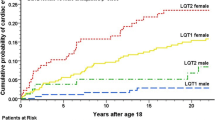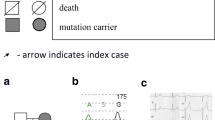Abstract
Long QT syndrome (LQTS) can cause syncope, ventricular fibrillation, and death. Recently, several disease-causing mutations in ion channel genes have been identified, and compound mutations have also been detected. It is unclear whether children who are carriers of compound mutations exhibit a more severe phenotype than those with single mutations. Although predicting phenotypic severity is clinically important, the availability of prediction tools for LQTS is unknown. To determine whether the severity of the LQTS phenotype can be predicted by the presence of compound mutations in children is needed. We detected 97 single mutations (Group S) and 13 compound mutations (Group C) between 1998 and 2012, age at diagnosis ranging 0–19 years old (median age is 9.0) and 18.0 years of follow-up period. The phenotypes and Kaplan–Meier event-free rates of the two groups were compared for cardiac events. This study investigated phenotypic severity in relation to the location of mutations in the protein sequence, which was analyzed using two sequence homology-based tools. In results, compound mutations in children were associated with a high incidence of syncope within the first decade (Group S: 32 % vs. Group C: 61 %), requiring an ICD in the second decade (Group S: 3 % vs. Group C: 56 %). Mortality in these patients was high within 5 years of birth (23 %). Phenotypic prediction tools correctly predicted the phenotypic severity in both Groups S and C, especially by using their coupling method. The coupling prediction method is useful in the initial evaluation of phenotypes both with single and compound mutations of LQTS patients. However, it should be noted that the compound mutation makes more severe phenotype.



Similar content being viewed by others
Abbreviations
- ECG:
-
Electrocardiogram
- ICD:
-
Implantable cardioverter-defibrillator
- LQTS:
-
Long QT syndrome
- PolyPhen-2:
-
Polymorphism phenotyping version 2
- POS:
-
Possibly damaging
- PRB:
-
Probably damaging
- QTc:
-
Corrected QT
- SIFT:
-
Sorting intolerant from tolerant
References
Goldenberg I, Moss AJ (2008) Long QT syndrome. JACC 51:2291–2300
Schwartz PJ, Priori SG, Spazzolini C, Moss AJ, Vincent GM, Napolitano C et al (2001) Genotype-phenotype correlation in the long QT syndrome: gene-specific triggers for life-threatening arrhythmias. Circulation 103:89–95
Priori SG, Schwartz PJ, Napolitano C, Bloise R, Ronchetti E, Grillo M et al (2003) Risk stratification in the Long QT syndrome. N Engl J Med 348:1866–1874
Schwartz PJ, Moss AJ, Vincent GM, Crampton RS (1993) Diagnostic criteria for the long QT syndrome. An update. Circulation 88:782–784
Johnson MM, Houck J, Chen C (2005) Screening for deleterious nonsynonymous single-nucleotide polymorphisms in genes involved in steroid hormone metabolism and response. Cancer Epidemiol Biomark Prev 14:1326–1329
Westenskow P, Splawski I, Timothy KW, Keating MT, Sanruinetti MC (2004) Compound mutations: a common cause of severe long QT syndrome. Circulation 109:1834–1841
Wang R-R, Li N, Zhang Y-H, Wang L-L, Teng S-Y, Pu J-L (2011) Novel compound heteroxygous mutations T2C and 1149insT in the KCNQ1gene cause Jervell and Lange–Nielsen syndrome. Int J Mol Med 28:41–46
Fodstad H, Bendahhou S, Rougier JS, Laitinen-Forsblom PJ, Barhanin J, Abriel H et al (2006) Molecular characterization of two founder mutations causing long QT syndrome and identification of compound heterozygous patients. Ann Med 38:294–304
Grunnet M, Behr ER, Calloe K, Hofman-Bang J, Till J, Christiansen M et al (2005) Functional assessment of compound mutations in the KCNQ1 and KCNH2 genes associated with long QT syndrome. Heart Rhythm 2:1238–1249
Yamaguchi M, Shimizu M, Ino H, Terai H, Hayashi K, Kaneda T et al (2005) Compound heterozygosity for mutations Asp611→Thy in KCNQ1 and Asp609→Gly in KCNH2 associated with severe long QT syndrome. Clin Sci 108:143–150
Itoh H, Shimizu W, Hayashi K, Yamagata K, Sakaguchi T, Ohno S et al (2010) Long QT syndrome with compound mutations is associated with a more severe phenotype: a Japanese multicenter study. Heart Rhythm 7:1411–1418
Shimizu W, Horie M, Ohno S, Takenaka K, Yamaguchi M, Shimizu M et al (2004) Mutation site-specific differences in arrhythmic risk and sensitivity to sympathetic stimulation in the LQT1 form of congenital long QT syndrome: multicenter study in Japan. J Am Coll Cardiol 44:117–125
Moss AJ, Shimizu W, Wilde AA, Towbin JA, Zareba W, Robinson JL et al (2007) Clinical aspects of type-1 long QT syndrome by location, coding type, and biophysical function of mutations involving the KCNQ1 gene. Circulation 115:2481–2489
Author information
Authors and Affiliations
Corresponding author
Ethics declarations
Conflicts of interest
There are no conflicts of interest to declare.
Rights and permissions
About this article
Cite this article
Izumi, G., Hayama, E., Yamazawa, H. et al. Compound Mutations Cause Increased Cardiac Events in Children with Long QT Syndrome: Can the Sequence Homology-Based Tools be Applied for Prediction of Phenotypic Severity?. Pediatr Cardiol 37, 962–970 (2016). https://doi.org/10.1007/s00246-016-1378-7
Received:
Accepted:
Published:
Issue Date:
DOI: https://doi.org/10.1007/s00246-016-1378-7




